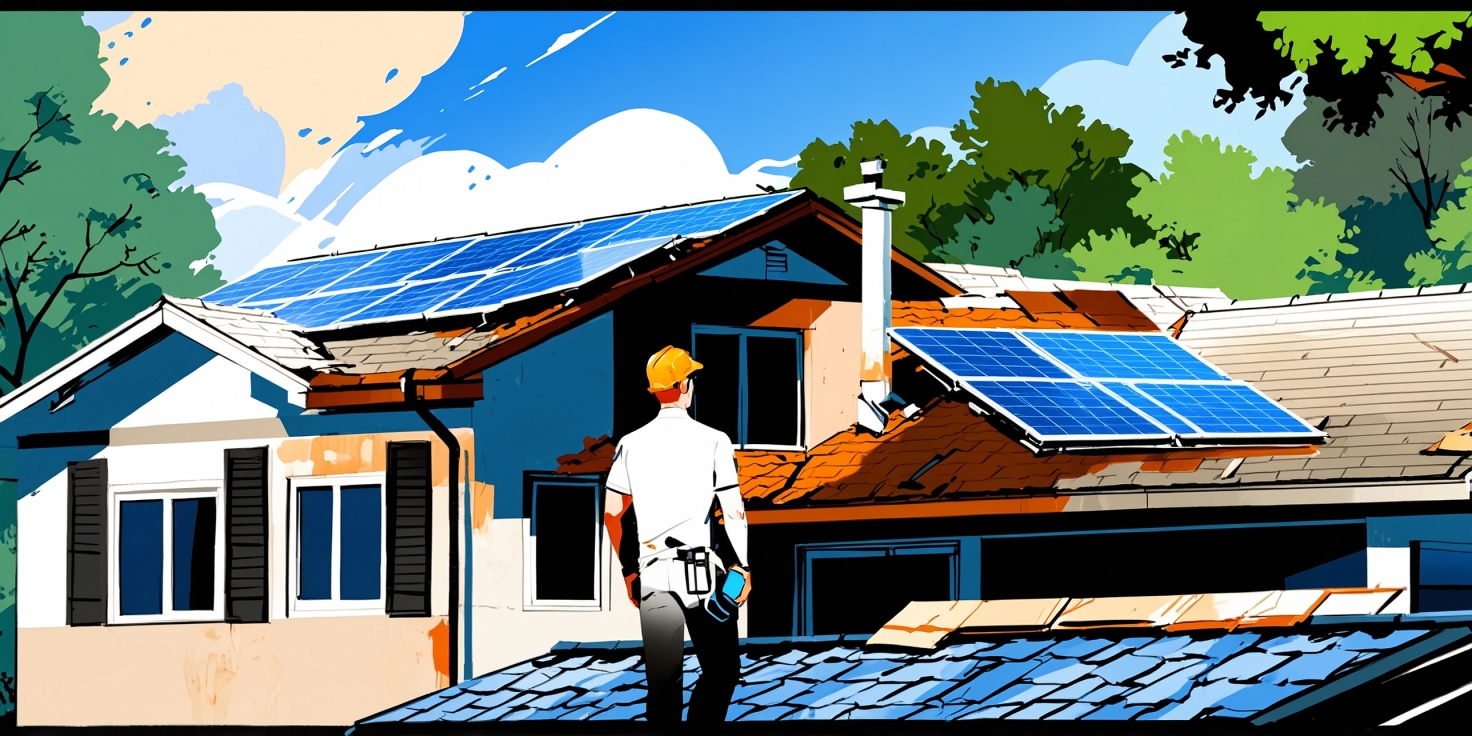Understanding the Impact of Storms on Solar Panels
Solar panels are a fantastic investment for homeowners looking to save on energy bills and reduce their carbon footprint. But when Mother Nature throws a tantrum—think hurricanes, hailstorms, or heavy winds—your sleek solar setup can take a serious hit. If you live in storm-prone areas like South Florida, you know exactly what I’m talking about.
Storms can cause a variety of damage to solar panels: shattered glass, dislodged panels, electrical issues, or even complete system failure. And while solar panels are built to be tough, they’re not invincible. That’s why it’s crucial to understand how to file a claim for storm-damaged solar panels effectively and efficiently.
Before diving into the claim process, it’s important to assess the damage. After a storm, take a walk around your property (only when it’s safe, of course). Look for visible signs of damage like cracks, broken mounts, or panels that have shifted. If you’re unsure, it’s always a good idea to call in a professional to inspect the system.
At LMR Public Adjusters, South Florida’s premier public adjusters, we specialize in helping property owners like you navigate the complex world of insurance claims. Our personalized, dedicated team is here to advocate for you and ensure you get the maximum payout possible.
Want to learn more about how we help with property claims? Or maybe you’re curious about our Google reviews? We’ve got you covered.
Reviewing Your Insurance Policy
Let’s be honest—insurance policies aren’t exactly light reading. They’re packed with legal jargon and fine print that can make your head spin. But when it comes to filing a claim for storm-damaged solar panels, understanding your policy is half the battle.
Start by locating your homeowner’s insurance policy. Most policies cover damage to solar panels, especially if they’re permanently attached to your roof. However, coverage can vary depending on your provider and the type of storm. For example, some policies may cover wind damage but exclude hail or flooding.
Look for sections in your policy that mention “dwelling coverage,” “other structures,” or “equipment breakdown.” These are the areas most likely to include your solar panels. If you’re still scratching your head, don’t worry—this is where LMR Public Adjusters steps in. We’ll review your policy with a fine-tooth comb and explain exactly what’s covered and what’s not.
It’s also important to check your deductible. This is the amount you’ll need to pay out-of-pocket before your insurance kicks in. If the cost to repair your solar panels is less than your deductible, it might not be worth filing a claim. But again, that’s something our team can help you evaluate.
Need help understanding your policy? Visit our FAQ page or check out our blog for more tips and insights.
Documenting the Damage
Now that you’ve reviewed your policy, it’s time to gather evidence. Think of this step as building your case. The more documentation you have, the stronger your claim will be.
Start by taking clear, high-resolution photos of the damage. Capture multiple angles and include wide shots of your roof as well as close-ups of the affected panels. If possible, take “before and after” photos to show the extent of the damage. Don’t forget to document any damage to related systems like inverters or wiring.
Next, write a detailed description of what happened. Include the date and time of the storm, the type of weather event, and any immediate effects you noticed (like power outages or system malfunctions). If you have a weather report or news article about the storm, include that too—it helps establish context.
Keep all receipts and invoices related to your solar panel system, including installation, maintenance, and repairs. These documents will help establish the value of your system and support your claim.
And here’s a pro tip: create a digital folder to store all your documentation. That way, everything is in one place when it’s time to submit your claim.
If you’re unsure about what to document, give us a call at LMR Public Adjusters. We’ve helped countless homeowners in areas like Fort Lauderdale and Hollywood, FL gather the right evidence to support their claims.
Filing the Insurance Claim
Alright, you’ve assessed the damage, reviewed your policy, and gathered your documentation. Now comes the big step—filing the claim.
Start by contacting your insurance company as soon as possible. Most providers have a limited window for reporting storm damage, often 30 to 60 days. When you call, be prepared to provide your policy number, a description of the damage, and the date of the storm.
Next, submit your documentation. This usually includes photos, written descriptions, receipts, and any other supporting materials. Some insurance companies allow you to upload these documents online, while others may require you to mail them in or meet with an adjuster in person.
Once your claim is submitted, the insurance company will assign an adjuster to assess the damage. This is where things can get tricky. Insurance adjusters work for the insurance company—not for you. Their goal is to minimize the payout, not maximize it.
That’s why it’s so important to have someone in your corner. At LMR Public Adjusters, we represent you—not the insurance company. Our team will meet with the adjuster, present your documentation, and fight to get you the compensation you deserve.
Need help filing your claim? Check out our services for home damage and commercial properties. We’ve got your back every step of the way.
Working with a Public Adjuster
If you’ve never worked with a public adjuster before, you might be wondering what we actually do. In simple terms, we’re your advocate in the insurance world. We handle the paperwork, negotiate with the insurance company, and make sure you get every dollar you’re entitled to.
Think of us as your personal claim concierge. We take the stress off your shoulders so you can focus on getting your life back to normal. And because we work on a contingency basis, we don’t get paid unless you do. That means our success is directly tied to yours.
At LMR Public Adjusters, we’ve helped thousands of homeowners across South Florida—from Pembroke Pines to Parkland—recover from storm damage and maximize their insurance claims.
We’ll start with a free consultation to review your policy and assess the damage. Then we’ll create a customized strategy to get your claim approved quickly and fairly. And we’ll keep you updated every step of the way.
Want to learn more about how we can help? Visit our location page to find a public adjuster near you.
Preventing Future Damage
Once your claim is settled and your solar panels are repaired, it’s time to think about the future. After all, South Florida isn’t exactly known for its mild weather. Taking steps to protect your solar investment can save you time, money, and headaches down the road.
Start by scheduling regular maintenance checks. A professional can spot potential issues before they become major problems. Make sure your panels are securely mounted and that all electrical components are in good working order.
Consider installing protective covers or shields to guard against hail and flying debris. You can also trim nearby trees to reduce the risk of branches falling on your panels during a storm.
And don’t forget about your insurance policy. Review it annually to make sure your coverage is up-to-date and includes protection for your solar system. If you’ve made upgrades or added new panels, let your insurance company know.
Need help preparing for the next storm? Check out our resources on wind damage, water damage, and mold damage. We’re here to help you stay one step ahead.
Conclusion
Filing a claim for storm-damaged solar panels might seem overwhelming, but it doesn’t have to be. With the right knowledge, documentation, and support, you can navigate the process smoothly and get the compensation you deserve.
Remember, your solar panels are a valuable asset. Don’t let storm damage go unchecked or under-compensated. Whether you’re dealing with cracked panels, electrical issues, or complete system failure, LMR Public Adjusters is here to help. Our dedicated team will fight for your rights and make sure your claim is handled with care and expertise.
Ready to take the next step? Contact us today for a free consultation and let us help you get back to sunny days—literally and financially.
What types of storm damage are typically covered by insurance for solar panels?
Most homeowner’s insurance policies cover damage from wind, hail, and lightning. However, coverage can vary, so it’s important to review your policy or consult with a public adjuster like LMR Public Adjusters to understand your specific coverage.
How long do I have to file a claim after a storm damages my solar panels?
Typically, you have 30 to 60 days to file a claim, but this can vary by insurance provider. It’s best to file as soon as possible to avoid complications or denial.
Can I file a claim if only one or two panels are damaged?
Yes, even minor damage can be covered under your policy. However, whether it’s worth filing depends on your deductible and the cost of repairs. A public adjuster can help you make that decision.
Do I need to be present when the insurance adjuster inspects my property?
It’s not required, but it’s highly recommended. Better yet, have a public adjuster from LMR Public Adjusters present to ensure your interests are represented during the inspection.
How can I prevent future storm damage to my solar panels?
Regular maintenance, protective covers, and trimming nearby trees can help. Also, review your insurance policy annually to ensure adequate coverage for your solar system.




